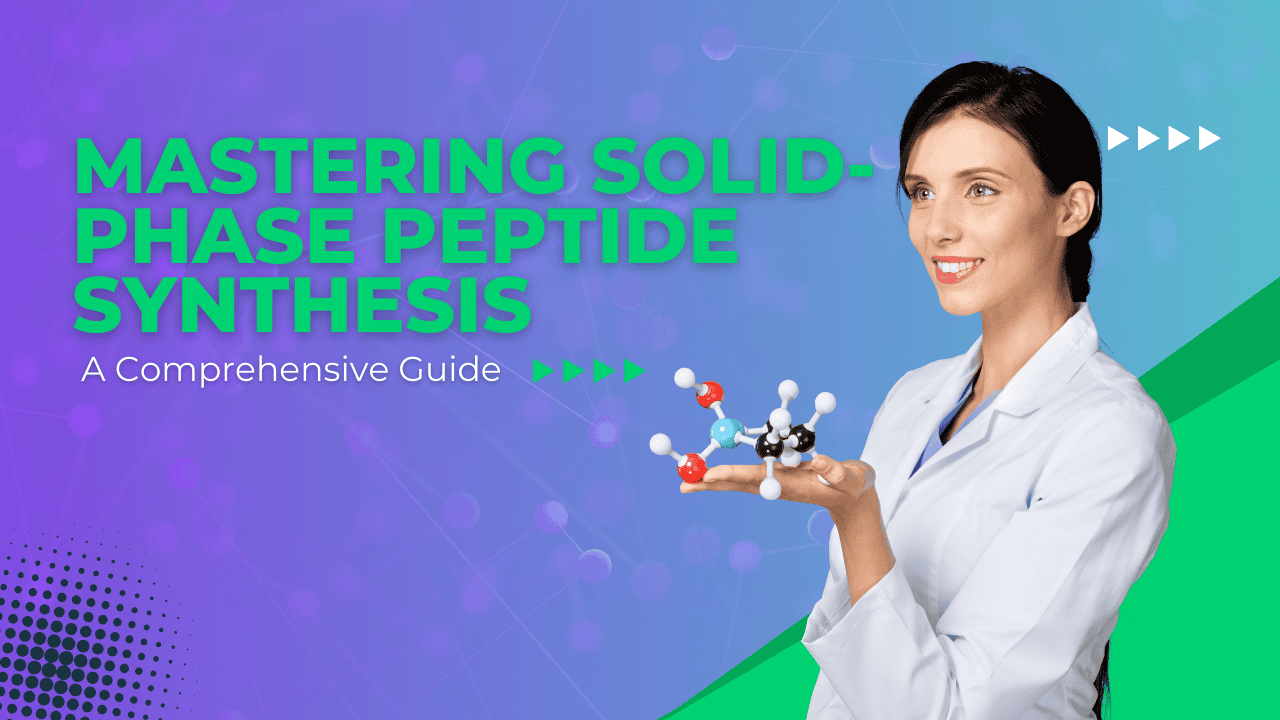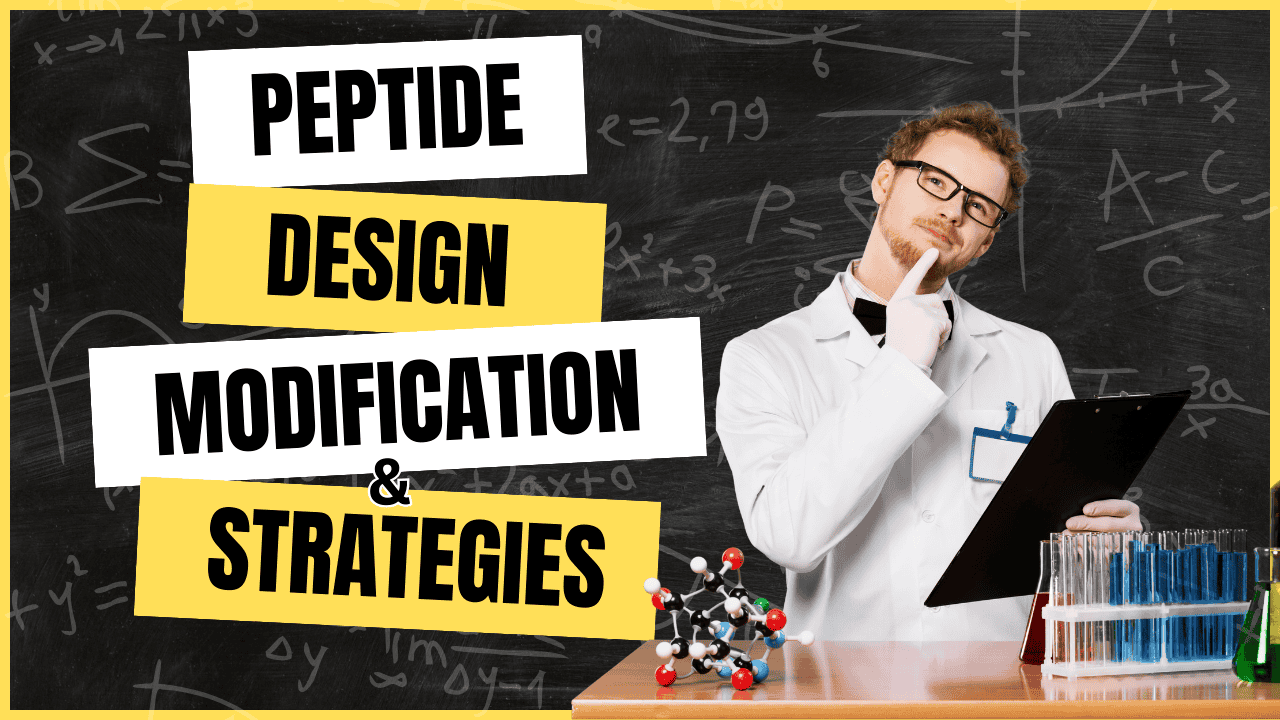

Dive into the intricate world of peptide and protein synthesis where methods like solid-phase peptide synthesis and liquid-phase peptide synthesis unravel the secrets behind creating synthetic peptides.
Learn about the journey from amino acids to peptides, the crucial role of coupling reagents, and the hurdles one might face along the way.
This guide provides valuable insights and practical tips for successful peptide production, optimizing both the simplicity and complexity of the synthesis process.
Peptide synthesis, a cornerstone of biochemistry, involves constructing peptides by linking amino acids through peptide bonds. This process underpins numerous scientific fields, from drug discovery to protein engineering. Imagine it as a meticulous assembly line where each amino acid is a brick, and their orderly arrangement creates life’s complex structures.
Solid-phase peptide synthesis (SPPS) has revolutionized peptide production. This method involves anchoring the first amino acid to a solid support or resin. Subsequent amino acids are then sequentially coupled. SPPS simplifies purification, as unreacted substances are easily washed away, leaving the growing peptide attached to the solid support.
Peptide synthesis is crucial for developing synthetic peptides used in research, medicine, and industry. These synthetic peptides help create peptide drugs, vaccines, and diagnostic tools, contributing to advancements in healthcare and biotechnology.
There are several methods for peptide synthesis, including liquid-phase and solid-phase peptide synthesis. Old-school liquid-phase synthesis, though still relevant, has largely been overshadowed by the more efficient SPPS. Both methods have unique advantages, tailored to different synthesis needs.
Solid-phase synthesis (SPS) involves creating peptides on a solid support, enabling sequential addition of amino acids. This method enhances efficiency and ease of purification. Imagine building a modest house – each brick is an amino acid, and SPS’s unique feature is that each new brick can be added without dismantling what’s already been built.
Solid-phase synthesis offers several benefits: it’s faster, more efficient, and allows easier purification of the peptide product. The solid support simplifies the process, making peptide synthesis more accessible even for complex sequences.
Choosing the right method for custom peptide synthesis depends on factors like peptide length, complexity, and desired purity. Custom peptide synthesis often leans towards solid-phase methods, given their efficiency and scalability.
SPPS is a robust technique where peptides are synthesized on a solid support. This method is a game-changer, allowing for automated, high-throughput peptide synthesis. It’s like following a recipe where each step is precisely controlled, ensuring consistent results.
Optimizing conditions in SPPS involves fine-tuning factors like solvent choice, reaction time, and temperature. Using high-quality reagents and maintaining stringent protocols are key to achieving high yields and purity.
Common challenges in SPPS include incomplete reactions, side reactions, and difficulties in handling long peptide chains. Overcoming these requires meticulous optimization and sometimes innovative strategies to drive difficult reactions to completion.
Designing a synthetic peptide involves selecting a target sequence, considering factors like peptide length, solubility, and biological activity. Tools like sequence analyzers aid in crafting peptides that meet specific research needs.
Tools used in synthetic peptide production include automated peptide synthesizers, resin supports, and purification systems. These technologies streamline the process, ensuring precise and efficient synthesis.
Advanced techniques in synthetic peptide synthesis include using novel coupling reagents and protective groups to enhance efficiency. Techniques like microwave-assisted synthesis and robotic automation are pushing the boundaries of peptide synthesis.
Amino acids are the building blocks of peptides. In peptide synthesis, each amino acid is sequentially added to form a peptide chain. The chemistry and reactivity of the amino acids dictate the synthesis process’s success.
Essential amino acids, such as lysine, arginine, and tryptophan, are vital for peptide and protein synthesis. These amino acids must be precisely incorporated to achieve functional peptides and proteins.
Selecting and activating amino acids in peptide synthesis involves using protective groups and coupling reagents. These steps ensure that amino acids react at appropriate sites, forming stable peptide bonds.
Solid support in peptide synthesis acts as a scaffold where the peptide grows. It facilitates the sequential addition of amino acids and simplifies purification by immobilizing the peptide.
Types of solid support used in SPPS include polystyrene-based resins and polyethylene glycol (PEG)-based supports. Each type offers specific advantages in terms of swelling properties, loading capacity, and compatibility with different solvents.
Attaching amino acids to solid support involves a process called “anchoring.” The first amino acid is covalently bonded to the resin, setting the stage for the sequential peptide synthesis to follow.
The primary difference between peptide and protein synthesis lies in the length and complexity of the molecules produced. Proteins are typically longer and more complex, requiring more intricate folding and post-synthetic modifications compared to peptides.
Peptides form proteins through folding and assembly. Once synthesized, the nascent peptide chain undergoes folding into specific structures, sometimes requiring assistance from chaperone proteins.
Peptides and proteins are synthesized in laboratories using automated synthesizers. These machines manage the sequential addition of amino acids, allowing for the efficient production of high-purity peptides and proteins.
Coupling reagents are chemicals used to drive the formation of peptide bonds between amino acids during peptide synthesis. They facilitate the efficient and selective joining of amino acids into a growing peptide chain.
Coupling reagents activate the carboxyl group of amino acids, enabling them to react with the amino group of another amino acid. This reaction forms a peptide bond, elongating the peptide chain.
Effective coupling reagents include HATU, HBTU, and DIC. These reagents vary in efficiency and are selected based on the specific requirements of the peptide synthesis process.
Improving coupling efficiency in peptide synthesis involves optimizing parameters like reaction time, temperature, and reagent concentration. High-quality reagents and accurate protocol adherence are essential.
Factors affecting coupling reactions include reagent purity, solvent choice, and reaction conditions. Careful control of these factors ensures successful peptide synthesis.
Best practices for successful coupling include using fresh reagents, maintaining clean synthesis environments, and conducting thorough monitoring of reaction progress. Regular calibration of equipment also helps in maintaining consistency.
The latest innovations in protein synthesis include advancements in automated synthesizers, more efficient coupling reagents, and novel protective groups that enhance peptide and protein synthesis.
Technology is advancing protein synthesis methods through automation, high-throughput systems, and sophisticated software that allows for precise control over the synthesis process. Innovations like microwave-assisted synthesis are reducing reaction times and increasing yields.
Emerging trends in protein and peptide synthesis include the use of bioinformatics tools for designing peptide sequences, green chemistry approaches to minimize environmental impact, and the development of peptide therapeutics for targeted drug delivery.
Customizing peptide synthesis involves designing peptide sequences tailored to specific applications, such as research, diagnostics, or therapeutic use. Each custom peptide is synthesized according to unique specifications to meet the desired needs.
Steps in custom peptide synthesis include sequence design, selection of appropriate synthesis methods, and purification. Quality control measures ensure that the final peptide product meets required standards.
Ensuring quality in custom peptide synthesis involves rigorous testing at each synthesis stage, including sequence verification and purity assessment. Using high-quality reagents and following standardized protocols are crucial.
Techniques ensuring efficient synthesis of peptides include automated synthesis, microwave-assisted reactions, and optimized coupling conditions. These techniques reduce reaction times and improve yields.
Minimizing errors during peptide synthesis involves maintaining a clean workspace, using accurate measurements, and performing regular equipment checks. Attention to detail at each synthesis step prevents common issues.
Key factors to consider when synthesizing peptides include the choice of synthesis method, quality of reagents, and reaction conditions. Proper planning and meticulous execution are essential for successful peptide synthesis.
Detailed steps in peptide synthesis include sequence design, resin loading, coupling of each amino acid, and final cleavage from the resin. Each step must be carried out precisely to ensure the desired peptide product.
Selecting the best method for peptide synthesis depends on peptide length, complexity, and intended use. SPPS is typically preferred for its efficiency and scalability, though liquid-phase synthesis may be suitable for specific cases.
Pros of SPPS include high efficiency and ease of purification. Liquid-phase synthesis may offer more control over reaction conditions but is often more labor-intensive. Understanding the specific requirements of the peptide synthesis can guide the choice of method.
Common challenges in peptide synthesis include incomplete reactions, side reactions, and handling long peptide sequences. These obstacles require careful planning and optimization to overcome.
Overcoming challenges in peptide and protein synthesis involves using high-quality reagents, optimizing reaction conditions, and implementing robust purification techniques. Innovation and persistence are key to success.
Solutions for long peptide synthesis include using advanced coupling reagents, optimizing solvent systems, and employing strategies like segment coupling. These approaches help ensure the synthesis of complex or lengthy peptides.
Safety measures for peptide synthesis include wearing appropriate personal protective equipment (PPE), using fume hoods, and handling chemicals with care. Proper training and following safety protocols are crucial.
Equipment needed for laboratory peptide synthesis includes peptide synthesizers, resin supports, analytical tools like HPLC for purification, and devices for monitoring reaction progress. Reliable and well-maintained equipment ensures successful synthesis.
Maintaining equipment for peptide synthesis involves regular cleaning, calibration, and servicing. Adhering to maintenance schedules and addressing issues promptly prevents disruptions and ensures consistent performance.
Standard experimental protocols in peptide synthesis include specific steps for resin loading, coupling, deprotection, and cleavage. Adhering to these protocols ensures successful peptide synthesis and consistent quality.
Documenting experiments in peptide synthesis involves recording detailed notes on each step, including reagent quantities, reaction conditions, and observations. Accurate documentation facilitates reproducibility and troubleshooting.
Protocols ensuring consistency in peptide synthesis include standardized operating procedures, thorough training, and rigorous quality control measures. Consistency is key to achieving high-quality peptide products.
Making peptide synthesis environmentally friendly involves using green chemistry principles, minimizing waste, and selecting eco-friendly solvents. Reducing energy consumption and improving efficiency also contribute to sustainability.
Environmental impacts of peptide synthesis include solvent waste and energy use. Efforts to mitigate these impacts focus on adopting greener synthesis methods and recycling or reusing materials.
Reducing waste in peptide synthesis involves optimizing reaction conditions to use less reagent and solvent, recycling materials, and implementing waste management strategies. Efficiency in synthesis reduces the overall environmental footprint.
Quality control measures in peptide synthesis include rigorous testing for purity, sequence verification, and structural confirmation using techniques like mass spectrometry and HPLC.
Testing purity of synthesized peptides involves analytical techniques like high-performance liquid chromatography (HPLC) and mass spectrometry. These methods ensure that the final product meets desired specifications.
Standards for high-quality peptide synthesis include achieving high purity, correct sequence, and desired biological activity. Adhering to these standards ensures that synthetic peptides meet research and application requirements.
The future of peptide and protein synthesis looks promising, with advancements in automation, greener synthesis methods, and the development of novel therapeutics. Continuous innovation drives this field forward.
Advances in technology will make peptide synthesis more efficient, scalable, and accessible. Innovations in automation, high-throughput screening, and bioinformatics will enhance peptide design and production.
Improved peptide synthesis will lead to new applications in drug development, personalized medicine, and diagnostics. Enhanced techniques will enable the creation of complex peptides and proteins with specific therapeutic properties.
In medicine, peptide synthesis is used to create peptide drugs, vaccines, and diagnostic agents. These synthetic peptides offer targeted treatments with fewer side effects, revolutionizing healthcare.
Industrial applications of peptide synthesis include manufacturing enzymes, agricultural bio-products, and fine chemicals. Synthetic peptides improve processes and products across various industries.
Synthetic peptides are used in research to study protein interactions, develop assays, and create models for drug testing. They provide valuable tools for understanding biological processes and disease mechanisms.
Notable case studies in peptide synthesis involve the development of peptide drugs, innovative synthesis techniques, and successful peptide-based therapeutics. These case studies highlight the impact of peptide synthesis on science and medicine.
Successful peptide syntheses have improved scientific understanding by enabling detailed studies of protein structure and function. They facilitate discoveries in molecular biology, enzymology, and drug development.
Lessons from real-world peptide synthesis include the importance of meticulous planning, the value of high-quality reagents, and the need for robust quality control. These lessons drive continuous improvement in peptide synthesis methods.
The most common method for synthesizing polypeptides is solid-phase peptide synthesis (SPPS). This method involves the sequential addition of amino acids to a growing peptide chain anchored to a solid resin. SPPS is widely used due to its efficiency and ability to simplify peptide purification.
Basic peptide synthesis involves linking amino acids together via peptide bonds. This process can be achieved using methods like solid-phase peptide synthesis (SPPS) or liquid-phase synthesis. Typically, it starts with anchoring the first amino acid to a solid support and sequentially adding amino acids, forming a peptide chain.
Peptides are synthesized using automated peptide synthesizers that facilitate either solid-phase or liquid-phase synthesis. These machines automate the coupling process, ensuring precise addition of amino acids to form the desired peptide sequence efficiently.
Peptides are generated through solid-phase synthesis or liquid-phase synthesis, where amino acids are sequentially added to form a peptide chain. Solid-phase peptide synthesis (SPPS) is particularly popular due to its efficiency and ease of purification.
Standard peptide synthesis refers to the conventional method of assembling peptides using techniques such as solid-phase peptide synthesis (SPPS). This method entails anchoring the first amino acid to a solid support and sequentially coupling subsequent amino acids until the desired peptide is cleaved.
Peptides are short chains of amino acids linked by peptide bonds. They play crucial roles in biological functions and are synthesized chemically for research and therapeutic applications. The synthesis process involves coupling amino acids in a specific sequence guided by peptide synthesis strategies.
The basic structure of a peptide consists of a sequence of amino acids linked by peptide bonds. Each amino acid contains an amino group, a carboxyl group, and a unique side chain that determines its properties and function.
Peptide bond formation occurs when the carboxyl group of one amino acid reacts with the amino group of another, releasing water (a dehydration reaction). This process, known as coupling, is facilitated by coupling reagents during peptide synthesis.
Peptides are synthesized either by solid-phase peptide synthesis (SPPS) or liquid-phase synthesis. SPPS involves anchoring the initial amino acid to a solid resin and sequentially adding amino acids. This method is efficient and simplifies purification.
Peptides are produced through chemical synthesis methods, primarily solid-phase peptide synthesis (SPPS). Automated synthesizers facilitate the process by adding amino acids in sequence, ensuring the formation of the peptide bond between two amino acids.
Dr. Bruce Merrifield is a legendary figure in the field of peptides, known for the invention of solid-phase peptide synthesis (SPPS), which revolutionized peptide manufacturing. With decades of dedicated research, Dr. Merrifield’s contributions have fundamentally shaped modern peptide synthesis techniques. His pioneering work earned him the Nobel Prize in Chemistry in 1984, underlining his unparalleled expertise and authority in peptide chemistry.
Dr. Merrifield’s notable publications include:
Solid Phase Peptide Synthesis. I. The Synthesis of a Tetrapeptide – This seminal paper, published in the Journal of the American Chemical Society, introduced SPPS and laid the groundwork for automated peptide synthesis. This publication has been cited extensively, serving as a cornerstone in the field.
Recent Advances in Solid Phase Peptide Synthesis – An influential article summarizing the advancements and refinements of SPPS, published in Angewandte Chemie International Edition. It provided deeper insights into synthetic strategies and resin chemistry.
Dr. Merrifield’s innovative approaches and relentless pursuit of knowledge have established him as a trusted and authoritative figure in peptide science. His work continues to inspire new generations of researchers, cementing his legacy in the synthesis of peptides and proteins.
Dr. Richard DiMarchi is a renowned expert in peptide therapeutics and peptide-based drug design. He has played a pivotal role in the development of several peptide drugs, significantly advancing therapeutic applications in diabetes, obesity, and oncology. With an extensive career spanning over three decades, Dr. DiMarchi has combined academic brilliance with industrial innovation, earning numerous accolades for his contributions to peptide science.
Key publications by Dr. DiMarchi include:
Design and Development of Novel Glucagon Analogs – This publication in Nature Reviews Drug Discovery explores the bioengineering of glucagon peptides for therapeutic use, influential in metabolic disease treatment. The study has been cited widely and underscores Dr. DiMarchi’s impact on endocrine research.
Peptide Therapeutics for Diabetes – Published in Nature Reviews Drug Discovery, this review discusses the design and clinical progress of peptide-based therapies for diabetes. It highlights innovative approaches and has significantly influenced research and clinical approaches in diabetes treatment.
Dr. DiMarchi’s work is characterized by a commitment to scientific excellence and an ability to translate fundamental research into clinical applications. His contributions have greatly enhanced the trustworthiness and advancement of peptide therapeutics, making him a leading figure in both academia and industry.
Brittain, W. D. G., & Coxon, C. R. (2021). Perfluoroaryl and perfluoroheteroaryl reagents as emerging new tools for peptide synthesis, modification and bioconjugation. Chemistry – a European Journal, 28(7). https://doi.org/10.1002/chem.202103305
Cheng, C., Wu, C., Hsu, W., & Wong, C. (2019). Programmable One-Pot synthesis of oligosaccharides. Biochemistry, 59(34), 3078–3088. https://doi.org/10.1021/acs.biochem.9b00613
Chow, H. Y., Zhang, Y., Matheson, E., & Li, X. (2019). Ligation technologies for the synthesis of cyclic peptides. Chemical Reviews, 119(17), 9971–10001. https://doi.org/10.1021/acs.chemrev.8b00657
Majidi, S., Sehrig, F. Z., Farkhani, S. M., Goloujeh, M. S., & Akbarzadeh, A. (2014). Current methods for synthesis of magnetic nanoparticles. Artificial Cells Nanomedicine and Biotechnology, 44(2), 722–734. https://doi.org/10.3109/21691401.2014.982802
Reguera, L., & Rivera, D. G. (2019). Multicomponent reaction toolbox for peptide macrocyclization and stapling. Chemical Reviews, 119(17), 9836–9860. https://doi.org/10.1021/acs.chemrev.8b00744
Schwieter, K. E., & Johnston, J. N. (2016). On-Demand Complex Peptide Synthesis: An aspirational (and elusive?) goal for peptide synthesis. Journal of the American Chemical Society, 138(43), 14160–14169. https://doi.org/10.1021/jacs.6b08663
ALL ARTICLES AND PRODUCT INFORMATION PROVIDED ON THIS WEBSITE ARE FOR INFORMATIONAL AND EDUCATIONAL PURPOSES ONLY. The products offered on this website are intended solely for research and laboratory use. These products are not intended for human or animal consumption. They are not medicines or drugs and have not been evaluated or approved by the FDA to diagnose, treat, cure, or prevent any disease or medical condition. Any form of bodily introduction is strictly prohibited by law.







Discount Applied Successfully!
Your savings have been added to the cart.